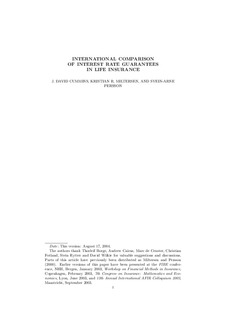| dc.description.abstract | Interest rate guarantees seem to be included in life insurance and pension products in most countries. The exact implementations of these guarantees vary from country to country and are often linked to different distribution of investment surplus mechanisms. In this paper we first attempt to model practice in Germany, the UK, Norway, and Denmark by constructing contracts intended to capture practice in each country. All these contracts include rather sophisticated investment surplus distribution mechanisms, although they exhibit subtle differences. Common for Germany, Denmark, and Norway is the existence of a bonus account, an account where investment surplus is set aside in years with good investment returns to be used to cover the annual guarantee in years when the investment return is lower than the guarantee. The UK contracts do not include annual bonus distribution, instead they include a potential bonus distribution at maturity of the contract.
These contracts are then compared with universal life insurance, a popular life product in the US market, which also includes annual guarantees and investment surplus distribution, but no bonus account. The contract parameters are calibrated for each contract so that all contracts have ’fair’ prices, i.e., the theoretical market price of the contract equals the theoretical market price of all future insurance benefits at the inception of the contract.
For simplicity we ignore mortality factors and assume that the benefit is paid out as a lump sum in 30 years.
We compare the probability distribution of the future payoff from the contracts with the payoff from simply investing in the market index. Our results indicate that the payoffs from the Danish, German and UK contracts are surprisingly similar to the payoff from the market index. We are tempted to conclude that the presence of annual guarantees and sophisticated investment surplus distribution, annual or at maturity only, have virtually no impact on the probability distribution of the payoff. The Norwegian contract has lower risk than the mentioned contracts, whereas the universal life contract offers the lowest risk of all contracts. Our numerical analysis therefore indicates that the relative simple and more transparent US contract provides the insurance customer with a less risky future benefit than the more complex (and completely obscure?) European counterparts. | en |
